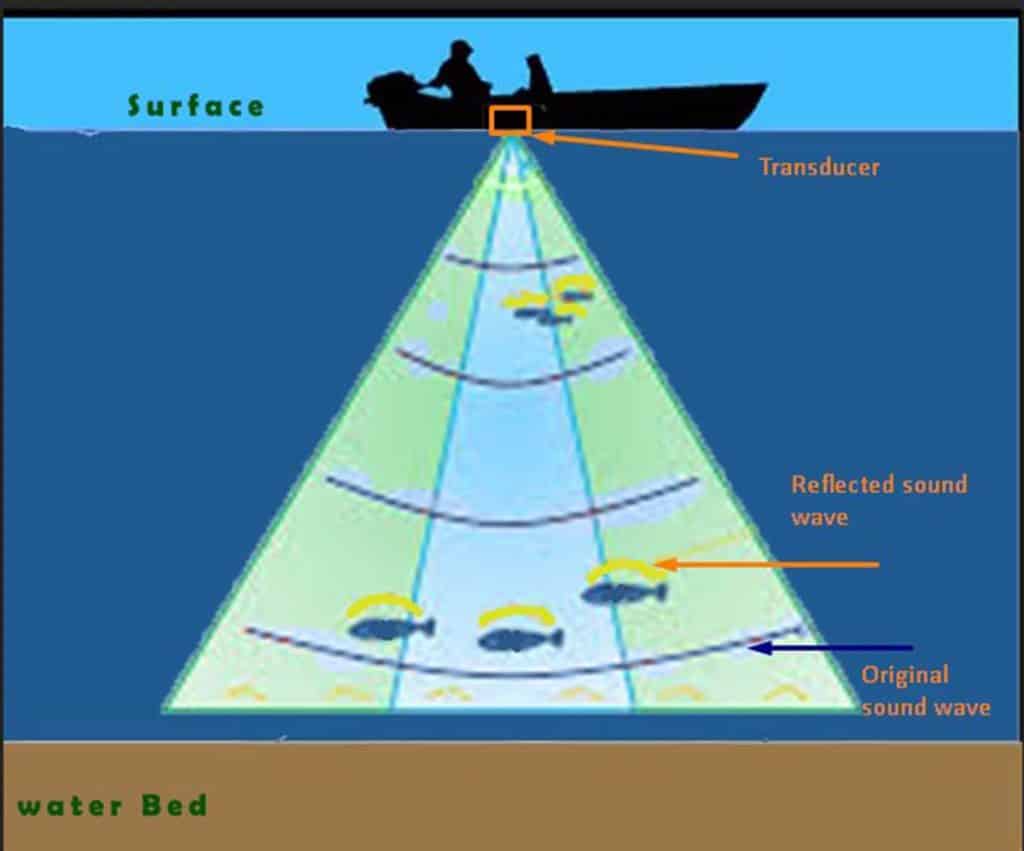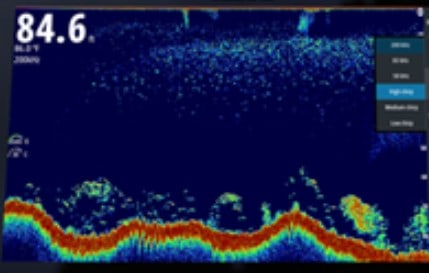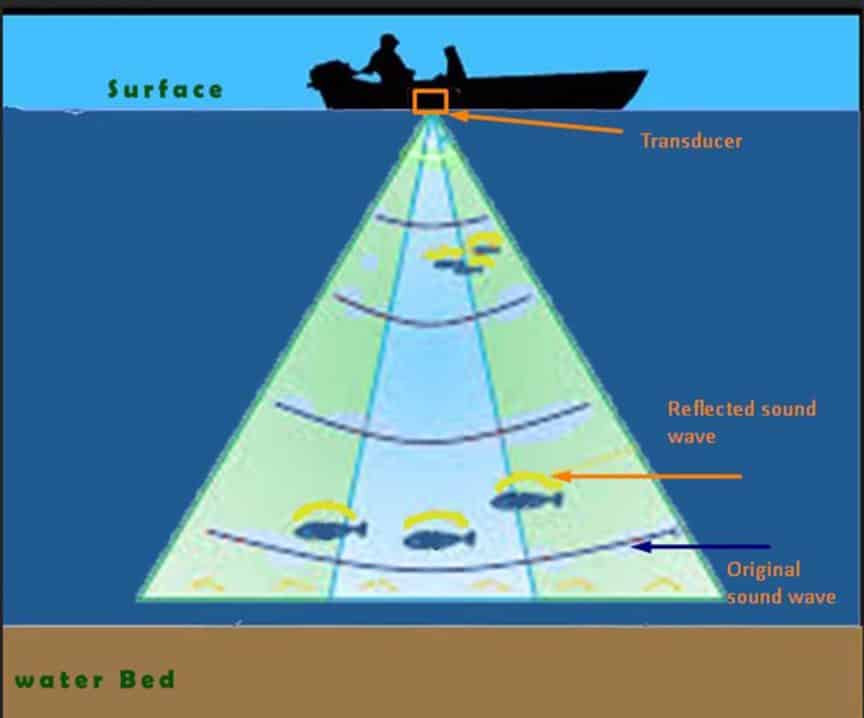
How Does A Fish Finder Work?
The world is absorbed into constant technology innovations and advancements in almost all fields. Talk of farming, education, employment, and business, just to mention a few. Regardless of the field that one can venture in, it has experienced tremendous technological growth from ancestral procedures of doing things. Fishing has not been left behind in the world of technology and innovation. In this article, we will focus on what the fish finder does, how does a fish finder work, how it’s used, and how to take readings from it, among other things. Enjoy your reading.
What Is A Fish Finder
It’s a device used by fishermen to discover the position of fish in the water or simply a device used by fishermen to find fish. In summary, they assist in the following.
- Identifying other objects underneath
- Ascertaining the approximate number of fish
- Recognizing the location of fish masses
- Finding the depth of water
- Detecting the type of fish beneath
- Measuring the water temperature
- Measuring the speed with which your boat is traveling on
- Learning how fish respond to your bait
How Does A Fish Finder Work Using Transducers?
The device sends sonar signals to water using transducers, which upon hitting the object (fish), take the estimated features of the object. An echo-sound is then returned to the device which is then converted into an image of what is happening underneath. Finally, the image is displayed on a screen for elucidation.
Let’s watch a video about how does a fish finder work using sonar waves. In this case, we have taken the example of a Humminbird fish finder as the principle of working is the same.
For improved aftermath, most fish finders use more than one frequency. The frequency used is proportional to the clarity and details received. Most of them have built-in GPS that aid in locating the geographical location.
Reading and interpreting the readings can be very tricky, but you don’t have to worry, by the end of this article, you will get all the information needed for accurate judgment. What does this reading really entail?
Reading A Fish Finder Screen

How To Read A Fish Finder Screen
Understanding or interpreting the images on the screen can be an uphill task, especially for beginners. In this article, we are just about to educate you on this.
By interpreting your screen, you can recognize where to target. The fish finders have a Fish-ID technology which has an aptitude to locate fish and other objects icons on the screen. All you need is to just read and comprehend the depth of each icon displayed. It won’t be any magic when you cast your net to a region of a high fish population only to come out with rocks and plants, some fish finders come with a few shortcomings. However, with time and experience, you will be accustomed to doing these things.
Fish arches can be your better selection though it also comes with a fair share of challenges. An arch fish finder represents fish as arches that are clearer than fish IDs. The bigger the arches the bigger the fish, though not in all cases. Although it’s somewhat cumbersome to isolate trees and rocks from arches, you will learn the skill with time.
You can agree with me that reading the screen is not as complex as it is portrayed sometimes, let’s now take time to know the available varieties of such devices.
Types Of Fish Finders
The market provides several types and brands of fish finders, their use depends on the objectives and nature of fishing.
Fishing in shallow water needs a higher frequency, over 200 kHz while deepwater needs a lower frequency. Fishing on salt waters will also need a lower frequency.
Fish finders with chartplotter, real-time mapping, better transducer, quality screen are most desired by the fishermen. A perfect example of that is the Lowrance Elite-7 Ti2 fish finding device.
For areas you are not familiar with, use a depth fish finder. Finally, if you will be fishing on ice water, you will need a wider cone angle so that you can see both deep in water and the environment around you. In modern ice fishing techniques, this type of fish finder is often used for better results. It should be added to your ice fishing gear list.
Some of them are portable yet others are fixed, especially for large boats.
Depending on your choice of a fish finder, the following modifications and overall options are available during your application of these devices in fishing.
Using A Fish Finder
We would like to share with you the best practices for handling your devices.
1. Thorough comprehension of the display
- Reading your manual. Your device will surely come with a guide, read through it, and refer to it again when necessary.
- Study the basic information about the speed of your boat, temperature, and the depth it can measure. This information is usually found on a screen of your fish finder.
- Since the screen will display the latest information towards the right, read your screen from your right to the left.
- It’s important to note that the topmost image on your screen is your boat, therefore, it’s good to take the reading from to top to the bottom
2. Locate the fish on the screen
- Look out for smaller patches for smaller fish and large patches/dots for the big fish
- Identify the nature of the terrain beneath. The tick line at the bottom of your screen describes the bottom. The presence of a line means that you’re floating on soft (sand or mud) ground while the absence of a line could mean that you’re on the hard or rocky ground.
- Combine your fish finder with a chart plotter which helps mark areas of interest to be revisited later.
3. Adjust the screen display
- When you notice an area of interest, zoom in for maximum clarity
- Adjust color resolution until the images are very clear
- Increase your fish finder speed so that you will be receiving updated images
- In case you are not conversant with reading the screen, use fish symbols that you are used to
4. Pick the transducer
Adjust your device’s sensitivity when it inaccurately detects fish locations, this can be done manually.
- Depending on the fish finder you’re using, adjust the range, usually at least thrice the depth
- Increase the sensitivity of your fish finder until two reading lines appear on the screen.
We must mention that not all the procedures as highlighted apply to all fish finders, you will be required to make an appropriate selection of technique, based on the several above mentioned aspects.
After reading the article this far, you are now in a position to purchase yours, but how will you go about it? Keep reading.
Factors To Consider Before Buying A Fish Finder
At this point, I think we all know how does a fish finder work using sonar technology. Before selecting the right fish finder for our purpose we should know something more about the devices.
1. Choose between the fixed or portable
The choice is yours but consider the below factors.
A portable has the following advantages.
- They’re versatile i.e. they allow all types of fishing, both canoe or lake fishing
- They’re good for fishermen who rent boats and can be useful as a kayak fish finder.
- They’re light and easy to transport and move around with
A fixed one has the following advantages.
- They’re high-tech hence perform best
- Can accommodate large screen for clear images
- Good for people who own boats
2. Consider the screen size
A large screen gives more space to display pictures as obtained from below leading to improved clarity. However, do not sacrifice vital specifications for a screen.
The other important aspect to consider is the number of pixels, the higher the number, the more the clarity. Also, remember to ensure that your screen is waterproof.
3. Glare protection during sunny days
During bright sun in the sea, it gets to point that you cannot read your screen. Since it’s hard to get shade in the sea, buy screens whose brightness and contrast can be lowered. You can as well consider buying glare-resistant screens.
4. Power
Devices with more power (wattage) are more powerful to give higher speed and accuracy.
5. Screen Backlight
If you will be fishing late in the night or early morning, buy fish finders whose screens have some backlight.
6. GPS
Unlike pier or shoreline fishing, boat or kayak fishing require GPS integrated fish finder.
7. Price
Don’t consider price only in making your purchase, but consider all factors as listed above. Even if the cost is high, it’s worth the investment.
8. Frequency
The preferred frequency will be determined by the nature of fishing to be done.
Using Bluetooth, iOS, iPhone, & Android In Fishing
Fishing is getting interesting and convenient. There are fish finders that are compatible and can be used with mobile phones and tablets.
These Bluetooth fish finders usually float on water near the fisherman. They emit ultrasound waves downwards to the waters which interact with fish and the objects beneath.
The data generated is then sent to a mobile device or tablet via Bluetooth for reading and interpretation. Once you identify where the school of fish is, you can cast your rod.
There are recommended applications that help read the signals from your fish finder, which you must install on your mobile device. Below are three main aspects to look for in the app.
- It should be updated regularly with a change in technology
- It should be reliable whenever needed
- Finally, it should have several features to be able to do everything you need.
If you are a technology enthusiast, this is the way to go, just ensure that you buy a gadget (Smartphone) that is compatible with fish finders, and then make use of technology.
Final Comments
I am only left to imagine the nature of fishing for 50 years to come, perhaps it will undergo extraordinary technological mutation. Today I know how does a fish finder work but, within a few years, it can be totally different.
Evidently, the ease with which fish is caught has transformed the fishing industry. In this article, all the current information about it has been articulated, we believe that you are transformed too. Based on the features and processes described above, you can select the best brand and type of your device from the varieties offered in the market. For further details, you can read reviews for different brands.
Certainly, you have noticed that technology is not static and wouldn’t wish to be left behind, keep visiting our site for updates as and when we receive them. We are delighted that you’re enlightened.



